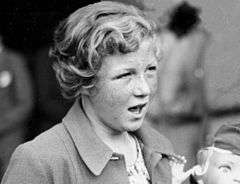Inge Sørensen
Inge Sørensen (by birth), Inge Tabur (by marriage) or Lille henrivende Inge (Little Lovely Inge) was born 18 July 1924 in Skovshoved, Denmark, and died 9 March 2011 in New Jersey. She was a Danish swimmer, who at age 12 won a bronze medal in 200 meter breaststroke at the 1936 Summer Olympics in Berlin.
 Inge Sørensen in 1936 | |||||||||||||||||
| Personal information | |||||||||||||||||
|---|---|---|---|---|---|---|---|---|---|---|---|---|---|---|---|---|---|
| Born | 18 July 1924 Skovshoved, Denmark | ||||||||||||||||
| Died | 3 March 2011 (age 86) New Jersey, USA | ||||||||||||||||
| Sport | |||||||||||||||||
| Sport | Swimming | ||||||||||||||||
Medal record
| |||||||||||||||||
During 1936-1944 she won nine Danish championships, two Nordic championships and one European championship.[1] She set 14 Danish records in breaststroke.[2] She also broke the world record on 400 m and 500 m breaststroke and became the first Danish female swimmer under 3 minutes on 200 m breaststroke.
Her swimming career was cut short by World War II. After the war she married a Danish engineer and moved abroad eventually residing in USA.
Early life
Inge Sørensen was born the daughter of a fishmonger in 1924.[3] She began swimming at age 3 in the harbor of Skovshoved north of Copenhagen and won her first Danish championship age 11 in 1936 on 200 m breaststroke.[4] Because of this she was selected for the Olympic Games in Berlin the same year.[5]
Olympic Games in Berlin 1936

At the Olympic Games at age 12 she won a bronze medal on 200 m breaststroke.[6][n 1] She is the youngest medal-winner at the Olympic Games in an individual competition.[7] Her final on August 11 was the first event to be broadcast live on air by Danish radio, which itself was a sensation.[8] During the games she got the nickname Lille henrivende Inge (Little Lovely Inge).[9]
On return from Berlin she and the other Danish female medal-winner, Ragnhild Hveger, received a chaotic welcome in Copenhagen.[n 2]
European Championships in London 1938
Between 1936 and 1938 Inge Sørensen improved her times in swimming though it was feared that puberty would slow her down.[11] At the European championships in swimming in London 1938 she won a gold medal in 200 m breaststroke.[12]
She was not the only Danish woman with success because Denmark became best nation for female swimmers.[13][n 3]
World War II
The period 1939-1941 was the height of her career. In 1939 she broke the world record on 400 m and 500 m breaststroke and in 1941 she became the first Danish female swimmer under 3 minutes on 200 m breaststroke.[2][n 4]
Nevertheless, World War II ment that the Summer Olympics in 1940 and 1944 were cancelled together with the European Championships in 1942. This made her end her swimming career in 1944.[15]
Unlike other Danish swimmers, such as Ragnhild Hveger, she did not go to Germany for international competition during the war.[15]
Later life
Inge Sørensen took a education in instructing and coaching in 1946 and afterwards taught gymnastics and swimming. After being married in 1948 to Danish engineer Janus Tabur, she followed him to South Africa and later Canada and from 1951 United States.[15] She lived here in New Jersey until her death in 2009.[16]
Notes
- She was one of three Danish female swimmers in this discipline in 1936. Accidentally, another Danish woman, Else Jacobsen, won bronze on the same distance at the Olympic Games in 1932
- 30000 people waited for them at the station and blocked all exits so they had to leave along the railroad track. Inge lost her doll, probably the one in the photo.[10]
- Good coaching was seen as the secret behind the success since Denmark was small and lacked modern facilities.[14]
- Danish female swimmer Rikke Møller Pedersen holds the world record on 200 m breaststroke as of 2019. Time: 2 min 19.11 sec
References
- "Inge Sørensen (1924 - 2011)". Dansk Kvindebiografisk Leksikon. Retrieved 24 June 2019.
- BoeN. "Inge Sørensen". Gyldendals Den store Danske. Gyldendal. Retrieved 24 June 2019.
- Heizs 2014, p. 63.
- Heizs 2014, pp. 64-65.
- Heizs 2014, p. 67.
- Heizs 2014, p. 77.
- "Inge Sørensen". SR/Olympic Sports. Archived from the original on 17 April 2020. Retrieved 24 June 2019.CS1 maint: ref=harv (link)
- Heizs 2014, p. 116.
- Heizs 2014, p. 76.
- Heizs 2014, pp. 148-151.
- Heizs 2014, p. 307.
- Heizs 2014, p. 467.
- Heizs 2014, p. 481.
- Heizs 2014, p. 473.
- Heizs 2014, p. 514.
- Heizs 2014, p. 513.
Bibliography
- Heizs, Tommy (2014). Svømmepigerne, der forførte Danmark i 1930'erne [The Swimming Girls who Seduced Denmark in the 1930s] (in Danish). Informations Forlag.CS1 maint: ref=harv (link)
| Wikimedia Commons has media related to Inge Sørensen. |